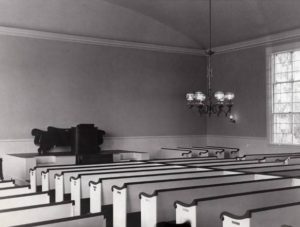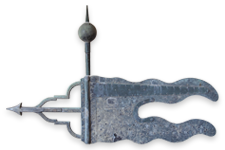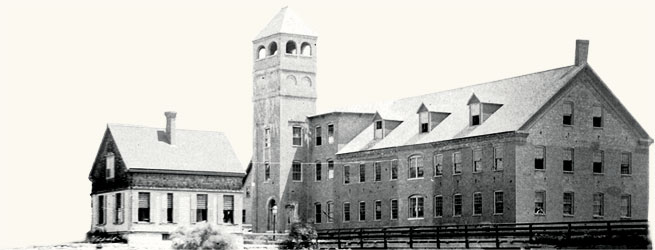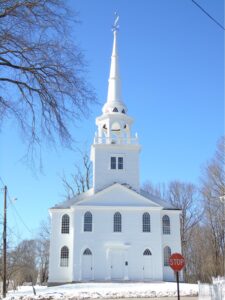
Summer 2024 Open Hours: 6/15, 6/27, 7/13, 7/25, 8/7, and 8/24 from 1:00-3:00pm. Drop in to have a peek at the Meetinghouse! Docents will be on site. Free
Yarmouth’s Old Meetinghouse on the Hill at 25 Hillside Street is a community treasure. Originally built in the 1790s and renovated in the 1820s and ‘30s, the building is a beautifully preserved artifact from Yarmouth’s past. At the end of 2022, Yarmouth Historical Society gratefully accepted the management and administration of the Meetinghouse, which is owned by the Town of Yarmouth. Previously, the Village Improvement Society had served as caretaker of the building from 1946 until its dissolution in 2022. All of us at the History Center are proud to honor the VIS’ legacy in continuing this important work.
Today, the Meetinghouse is available for weddings, funerals, church services, concerts, appropriate theatrical productions and other events from May through October. Please contact History Center staff for more information about scheduling events, rental fees, and other considerations: info@yarmouthmehistory.org or (207) 846-6259.
If you are interested in learning about serving on the Old Meetinghouse Advisory Committee, please contact Katie Worthing, Executive Director at Yarmouth History Center.
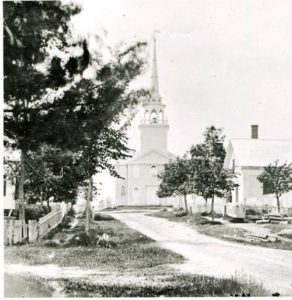
A Brief History of Yarmouth’s Old Meetinghouse
(Adapted from the Village Improvement Society website, which in turn relied on information from Ursula Baier’s lecture “The Old Meetinghouse on the Hill: Fact and Legend.” It reflects only part of the broad research Mrs. Baier conducted in providing us with a remarkable picture of the Meetinghouse over the years.)
In 1796 a group of Baptists petitioned the State of Massachusetts for permission to set up a new denomination in town. Land was purchased on Byram’s Hill in the upper village.
1796 The original building was of simple design, having an entrance under the tower which was topped by a small steeple. There were two rows of five small-paned windows on each side, box pews, galleries and a canopied pulpit with stairs leading up to it. As for as we know, the ten foot weathervane on the Meetinghouse today dates back to the original building. At the time, George Washington was the President of the United States. The Meetinghouse was built at a cost of about $6,790. The ‘raising’ of the frame took place April 30, 1796. There was an inscription on the west wall above the high pulpit reading “Erected AD 1796 Elder Thomas Green, Pastor”. Money to pay for the building was raised by the sale of pews which became the deeded property of the owners. The pews were square with doors, and seats on hinges.
1825 Major alterations were done on the façade of the building. A larger porch was built to provide a vestry*. Also, a new tower*, a belfry* and conical spire* were added. The spire was unusual because it was flush-boarded instead of 16-sided or shingled as was customary. The successful combination of pointed Gothic style arches* (on windows and side doorways) with Classical Doric details* (on the center doorway and tower) is noteworthy. The sides and interior were largely unchanged at this time.
1837 Major interior renovations in the Greek Revival style. The small windows were boarded up and replaced on each side by two big windows* with wooden blinds. Inside, the high pulpit, galleries and box pews were removed and the present slip pews* installed. A vaulted ‘barrel’ ceiling* lowered the height and was finished with a plaster medallion* and cornice*. New door and window trim* were added. The floor was raised at the rear to give better visibility. This is largely how we see the building today. The pews were again sold to pay for the renovation.
1889 The building ceased to be used as a church when the Baptists built their present church on Main Street. The Meetinghouse bell, originally hung in 1805 and thought to be the first church bell in town, was moved to the new church.
1890 The Meetinghouse was bought for $1000. by Mr. and Mrs. George Hammond and was renovated for use as the town’s first library and Antiquarian Society. Stained glass sash were installed in the side windows. The side wall lamps* were probably added at this time. It was known as Yarmouth Memorial Hall.
1910 The Meetinghouse was donated to the Town of Yarmouth and was used for town meetings until 1946. During World War II the belfry was manned by townspeople as an airplane spotting center in the Civil Defense System. Two hour shifts were stood by women during the day and by men at night up on the empty bell deck.
1946 The Village Improvement Society agreed to maintain the interior. Pews were restored, clear glass sashes were put back in the side windows, lamps were electrified, and a bathroom installed.
1948 At a Special Town Meeting on June 24, 1948, it was voted to “authorize the Selectmen, in behalf of the Town, to enter into an agreement with the Village Improvement Society of Yarmouth in consideration of the restoration of the interior of the Old Meetinghouse on the Hill, so called, whereby the Town will complete repairs on the exterior such as painting, necessary carpentry and things of like nature and assume such care in perpetuity, such being consistent with and will more fully and effectively accomplish the purposes of the trust under which said property was acquired by the Town”.
1975 – 1982 In order to halt and repair structural deterioration of the building a major restoration project was undertaken by the Village Improvement Society and the Town of Yarmouth under the guidance of the Society for the Preservation of New England Antiquities. During this time several sills were replaced, trusses reinforced, windows, exterior moldings and doors repaired, the steeple completely removed and rebuilt, the weathervane restored, and the entire building repainted inside and out in colors reminiscent of those used in the 1837 renovation.
1978 The Meetinghouse was entered in the National Register of Historic Places.
2000 – 2002 The Village Improvement Society and the Town of Yarmouth embarked on an urgently needed restoration project for the primary purpose of preserving the structural integrity of the building. The project included structural restoration of the foundation with some sill replacement, truss reinforcement, electrical upgrading, strengthening of the vaulted ceiling ribs, interior plaster restoration, calcimine paint removal and painting of the sanctuary vaulted ceiling, walls and the Narthex and a new roof. At the time of excavation for the foundation work, an archeological dig was performed under the supervision of an archeologist.
The three periods of construction of the building can be seen on the outside:
- The west end retains the appearance of the 18th century Meetinghouse.
- The façade reflects the 1825 Federal period.
- The sides date from the remodeling of 1837 when the Greek Revival details were added. The interior is also of this period.
*Denotes features which can still be seen in the building.
